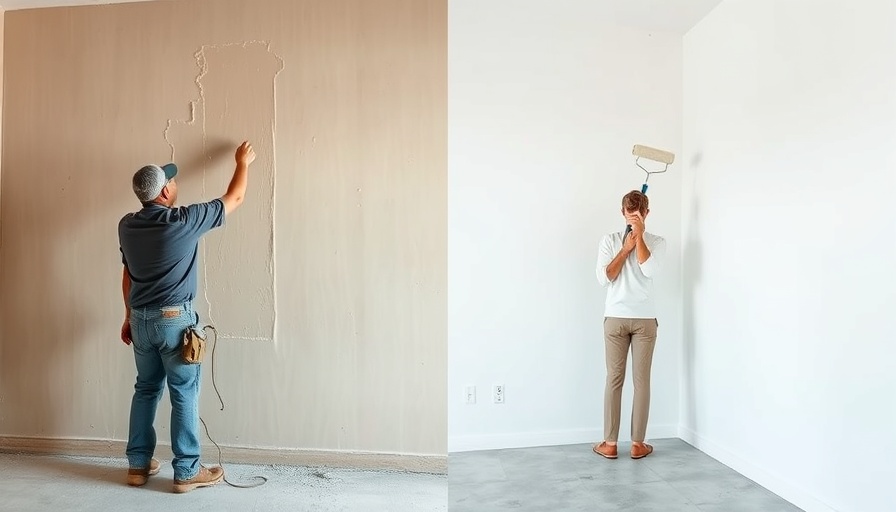
Revolutionizing Home Improvements: The Self-Leveling Wall Technique
In a world where home improvements can often seem overwhelming—especially for those without construction experience—new and innovative techniques are emerging that promise to make these projects more accessible. The concept of self-leveling walls is not just a theoretical idea but a practical solution that several DIY enthusiasts are now exploring. In Yasha Koshik Song's recent video titled DIY Perfectly Smooth Walls with Self-Leveling Floor! Budget House Project: 2 Floors for $1000, he showcases a method that allows anyone to achieve professional-quality walls with minimal effort and cost.
In DIY Perfectly Smooth Walls with Self-Leveling Floor! Budget House Project: 2 Floors for $1000, the discussion dives into innovative wall construction techniques, exploring key insights that sparked deeper analysis on our end.
The Beauty of Self-Leveling Technology
The cornerstone of this approach is the self-leveling compounds that have gained popularity for flooring applications. Koshik's innovation lies in adapting this technology for wall construction, providing a means to create ultra-smooth surfaces quickly. He demonstrated that even those who have never tackled a construction project can successfully implement this technique. By simply following some basic instructions and understanding the materials involved, homeowners can transform their living spaces without the need for professional help.
Understanding the Process
The method Koshik shares involves several easy-to-follow steps. Firstly, he suggests priming the surface with a deep-penetrating primer to ensure that the self-leveling compound adheres properly. Next, framing the area with borders prevents the mixture from spilling over. This skillful manipulation of materials showcases how basic tools and the right products can achieve high-end results.
Another important feature Koshik emphasizes is the spiked roller used to smooth out the compound as it sets. This tool is crucial for eliminating air bubbles, which compromises the finish quality. Interestingly, the entire process is remarkably forgiving, allowing even beginners to rectify minor missteps without jeopardizing the final effect.
A Buddy System for Success
While Koshik explores the option of completing these tasks solo, he mentions that larger projects might require a partner for efficiency. Collaboration in such DIY projects not only divides labor but also enhances the learning experience, making it easier to troubleshoot any issues that arise. The take-home message is that group effort can boost home improvement joy.
Keeping Costs Down Without Compromising Quality
For many homeowners, budget is a paramount concern. Koshik demonstrates that regardless of financial constraints, it's entirely possible to achieve beautiful, functional, and energy-efficient homes using affordable materials. He highlights products such as the Burgoff Easy Bowden compound that are suitable for any skill level, further legitimizing the viability of this approach for the average DIYer. Additionally, the long-term benefits of using quality materials like Penoplex for insulation prove that small investments today can lead to significant savings on energy costs down the road.
Your Renovation is Your Own
For homeowners aged 35-55 looking to enhance their living spaces, the flexibility of DIY projects means they can tailor everything to their unique taste and specifications without relying on contractors. Through Koshik's approach, it's clear that individuals equipped with basic skills can tackle significant renovation projects—personalizing their homes while learning new competencies along the way.
Future Implications for DIY Enthusiasts
The discussion sparked by Koshik’s video isn’t just about self-leveling walls; it’s about the broader potential of DIY renovations fueled by technology. As more individuals seek innovative methods to enhance their homes economically, we may see an industry shift towards user-friendly products aimed at a diverse clientele. For many, the lessons learned from such transformative experiences will encourage further exploration of advanced home improvement techniques.
It is precisely this spirit that fosters creativity, empowers homeowners, and ultimately promotes sustainable living. In both practical and emotional contexts, this movement toward DIY renovation resonates strongly with experienced and novice DIYers alike.
If you're inspired by Koshik's methods and are ready to begin your own home transformation, now is the time to explore the possibilities of self-leveling walls. Not only will you enhance the value of your home, but you will also gain a rewarding sense of accomplishment along the way.
 Add Row
Add Row  Add
Add 




Write A Comment